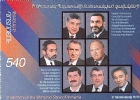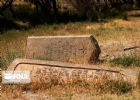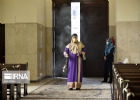
English :
01 Ağustos 2020
![]()
![]()
![]()
Council of State ruling on Hagia Sophia could set a precedent for Sanasaryan Han - 
In a news report on Sanasaryan Inn in İstanbul, Agos newspaper has written that the inn, which was confiscated from the Armenian community in Turkey in 1928, belongs to the Sanasaryan Foundation.
In explaining the reason why it has annulled the decree turning Hagia Sophia from a mosque into a museum in the year 1934, the Council of State has indicated that it was “allocated as a mosque as per the deed of trust of the pious foundation of Sultan Mehmed II.”
This recent verdict has also turned Sanasaryan Han (Inn) in Fatih, İstanbul into a current issue on the agenda. Sanasaryan Han was one of the confiscated properties of the Armenian community in Turkey.
In a news report entitled “Isn’t Sanasaryan Han the Charter of a Wakf [the deed of trust of a pious foundation]”, Agos newspaper has written that Sanasaryan Han belongs to the Sanasaryan Foundation [Wakf].
According to Agos, the Council of State verdict converting Hagia Sophia from a museum back into a mosque could also draw a new picture for us, especially about the confiscated properties of minorities in Turkey.
As a matter of fact, in explaining the reasons for its annulment of the Council of Ministers decree dated 1934, the Council of State has made quite a comprehensive reference to the fact that “Hagia Sophia was in the possession of Sultan Mehmed II’s pious foundation,” or wakf.
It brings Sanasaryan Han into minds
In the justification of its Hagia Sophia verdict, the Council of State has said, “It is without a doubt that a foundation voucher is in the capacity of a rule of law, the quality and intended purpose of the endowed real estate indicated in the foundation voucher shall not be changed and this fact shall be binding for all real persons as well as the defendant administration.”
The same mentality was also voiced by President of Religious Affairs.
Against this background, all these recent developments and statements bring Sanasaryan Han, one of the confiscated properties of Armenian community in Turkey, into agenda. Because Mıgırdiç Sanasaryan established the Sanasaryan Foundation in 1901 with the aim of “meeting the housing, education and nourishment needs of poor Armenian children.”
Accordingly, legal circles are now discussing that the Council of State verdict on Hagia Sophia could set a legal precedent for Sanasaryan Han and similar other confiscated foundation estates.
What happened in Sanasaryan Han?
Sanasaryan Han, which was the deed of trust of the pious foundation of Mıgırdiç Sanasaryan, was deemed as a fused foundation in the Republican era and was affiliated with the General Directorate of Foundations.
As per the foundation voucher which was officially registered by the court in October 1901 (the Ottoman era), Sanasaryan Foundation was established by Mıgırdiç Ağa Sanasaryan with the aim of meeting the education, housing and nourishment needs of poor Armenian children.
In order to fulfill this aim, Mıgırdiç Sanasaryan bought the Sanasaryan Han across the Gülhane Park. He named the Armenian Patriarch of İstanbul as the sole trustee and entitled authority of the foundation.
As the foundation was considered as a fused foundation in the Republican period, the Armenian Patriarchate filed a lawsuit to take the property back; however, this lawsuit was rejected. With the rejection of the lawsuit, the Patriarchate appealed to the Court of Cassation.
While the judicial process was still ongoing, the Directorate General of Foundations lodged a tender without waiting for the ruling of the supreme court and the Han was rented for a period of 20 years.
The 1st Civil Chamber of the Court of Cassation handed down its detailed ruling on December 13, 2017 and concluded that it was a community foundation; however, it then gave an exact opposite ruling.
In a statement last month, the Ministry of Culture and Tourism also said that there was nothing preventing Sanasaryan Han from being rented out.
Council of State ruling on Hagia Sophia
The 10th Chamber of the Council of State announced its ruling on Hagia Sophia’s status on July 10, 2020 and annulled the decree turning Hagia Sophia from a mosque into a museum.
In the ruling of the Council of State, it has been indicated that “Hagia Sophia was in the possession of Sultan Mehmed II’s pious foundation” and “it was offered for the use of society as a mosque.” The ruling has noted that Hagia Sophia was “registered as a mosque in the foundation voucher.”
“As it has been concluded that it is not legally possible for Hagia Sophia to be used for a qualification other than being a mosque, as it was allocated as per the deed of trust of the pious foundation, or to be allocated for another purpose, the Council of Ministers Decree, which is the matter in dispute in this case, ended its use as a mosque and converted it into a museum, has not been found lawful.”
In explaining the reason why it has annulled the decree turning Hagia Sophia from a mosque into a museum in the year 1934, the Council of State has indicated that it was “allocated as a mosque as per the deed of trust of the pious foundation of Sultan Mehmed II.”
This recent verdict has also turned Sanasaryan Han (Inn) in Fatih, İstanbul into a current issue on the agenda. Sanasaryan Han was one of the confiscated properties of the Armenian community in Turkey.
In a news report entitled “Isn’t Sanasaryan Han the Charter of a Wakf [the deed of trust of a pious foundation]”, Agos newspaper has written that Sanasaryan Han belongs to the Sanasaryan Foundation [Wakf].
According to Agos, the Council of State verdict converting Hagia Sophia from a museum back into a mosque could also draw a new picture for us, especially about the confiscated properties of minorities in Turkey.
As a matter of fact, in explaining the reasons for its annulment of the Council of Ministers decree dated 1934, the Council of State has made quite a comprehensive reference to the fact that “Hagia Sophia was in the possession of Sultan Mehmed II’s pious foundation,” or wakf.
It brings Sanasaryan Han into minds
In the justification of its Hagia Sophia verdict, the Council of State has said, “It is without a doubt that a foundation voucher is in the capacity of a rule of law, the quality and intended purpose of the endowed real estate indicated in the foundation voucher shall not be changed and this fact shall be binding for all real persons as well as the defendant administration.”
The same mentality was also voiced by President of Religious Affairs.
Against this background, all these recent developments and statements bring Sanasaryan Han, one of the confiscated properties of Armenian community in Turkey, into agenda. Because Mıgırdiç Sanasaryan established the Sanasaryan Foundation in 1901 with the aim of “meeting the housing, education and nourishment needs of poor Armenian children.”
Accordingly, legal circles are now discussing that the Council of State verdict on Hagia Sophia could set a legal precedent for Sanasaryan Han and similar other confiscated foundation estates.
What happened in Sanasaryan Han?
Sanasaryan Han, which was the deed of trust of the pious foundation of Mıgırdiç Sanasaryan, was deemed as a fused foundation in the Republican era and was affiliated with the General Directorate of Foundations.
As per the foundation voucher which was officially registered by the court in October 1901 (the Ottoman era), Sanasaryan Foundation was established by Mıgırdiç Ağa Sanasaryan with the aim of meeting the education, housing and nourishment needs of poor Armenian children.
In order to fulfill this aim, Mıgırdiç Sanasaryan bought the Sanasaryan Han across the Gülhane Park. He named the Armenian Patriarch of İstanbul as the sole trustee and entitled authority of the foundation.
As the foundation was considered as a fused foundation in the Republican period, the Armenian Patriarchate filed a lawsuit to take the property back; however, this lawsuit was rejected. With the rejection of the lawsuit, the Patriarchate appealed to the Court of Cassation.
While the judicial process was still ongoing, the Directorate General of Foundations lodged a tender without waiting for the ruling of the supreme court and the Han was rented for a period of 20 years.
The 1st Civil Chamber of the Court of Cassation handed down its detailed ruling on December 13, 2017 and concluded that it was a community foundation; however, it then gave an exact opposite ruling.
In a statement last month, the Ministry of Culture and Tourism also said that there was nothing preventing Sanasaryan Han from being rented out.
Council of State ruling on Hagia Sophia
The 10th Chamber of the Council of State announced its ruling on Hagia Sophia’s status on July 10, 2020 and annulled the decree turning Hagia Sophia from a mosque into a museum.
In the ruling of the Council of State, it has been indicated that “Hagia Sophia was in the possession of Sultan Mehmed II’s pious foundation” and “it was offered for the use of society as a mosque.” The ruling has noted that Hagia Sophia was “registered as a mosque in the foundation voucher.”
“As it has been concluded that it is not legally possible for Hagia Sophia to be used for a qualification other than being a mosque, as it was allocated as per the deed of trust of the pious foundation, or to be allocated for another purpose, the Council of Ministers Decree, which is the matter in dispute in this case, ended its use as a mosque and converted it into a museum, has not been found lawful.”
Bu haber Bianet kaynağından gelmektedir.
Haber metninde yer alan görüşler haber kaynağı (Bianet) ve yazarına ait olup,
bolsohays.com sitesi haber hakkında herhangi bir görüş üstlenmemektedir.
Opinions expressed are those of the author(s)-(Bianet). They do not purport to reflect the opinions or views of bolsohays.com
Diğer Haberler
-
Photography of Ancient Armenia Featured in New 2026 Wall Calendar
-
Pope asks for prayers ahead of visit to Türkiye and Lebanon
-
Armenia will step up its efforts toward membership in the European Union in 2026
-
Economy Minister discussed rebranding of Armenian brandy with producers
-
Aleppo - Yerevan - Aleppo
-
Mirzoyan: Armenia citizens should live in Armenia, Azerbaijan citizens should live in Azerbaijan
-
Armenia will officially receive the European Union`s visa liberalization action plan in the coming
-
Armenia might achieve visa-free travel to the European Union within two years
-
Armenia opens transit route between Azerbaijan and Türkiye
-
Armenia invites Erdogan, Aliyev to 2026 European Political Community Summit
-
Patrick Fiori to Compete in Eurovision 2027?
-
Armenian Wines Voskevaz Karasi Areni Noir And Haghtanak Win Gold at Prestigious U.S. Wine Competitio
Foto Galeri Tüm Galeriler
Video Galeri Tüm Videolar
-

Papa XIV. Leo`nun Türkiye Ziyareti | Volkswagen Arena Efkaristiya Ayini
-

Parliament Shooting in Armenia, October 27, 1999
-

Albert - Brave Heart | ???????? Armenia | Official Music Video | Junior Eurovision 2025
-

Սրբադասման Սուրբ Պատարագ եւ Հրեշտակ Տեառն Մարեմեան աղօթք 19 հոկտեմբեր 2025 – Լեւոն ԺԴ. Քահանայապետ
Anket Tüm Anketler
Günün Sözü
Մաքուր, համեստ եւ պարկեշտ նկարագրի տէր մարդը յաղթական մըն է, իսկ թոյլ բարոյականի տէրը, աննկարագիր մարդը պարտուած մըն է կեանքի պայքարին մէջ։














